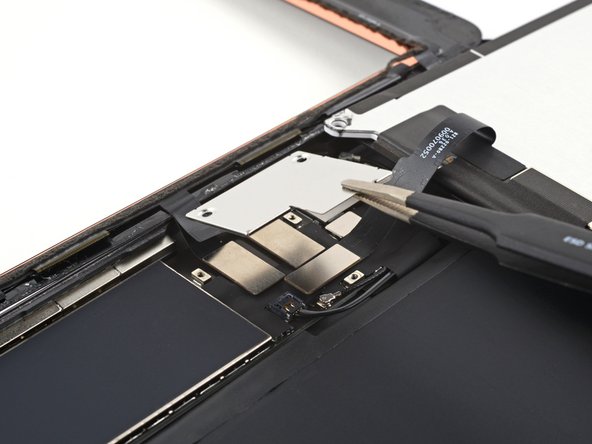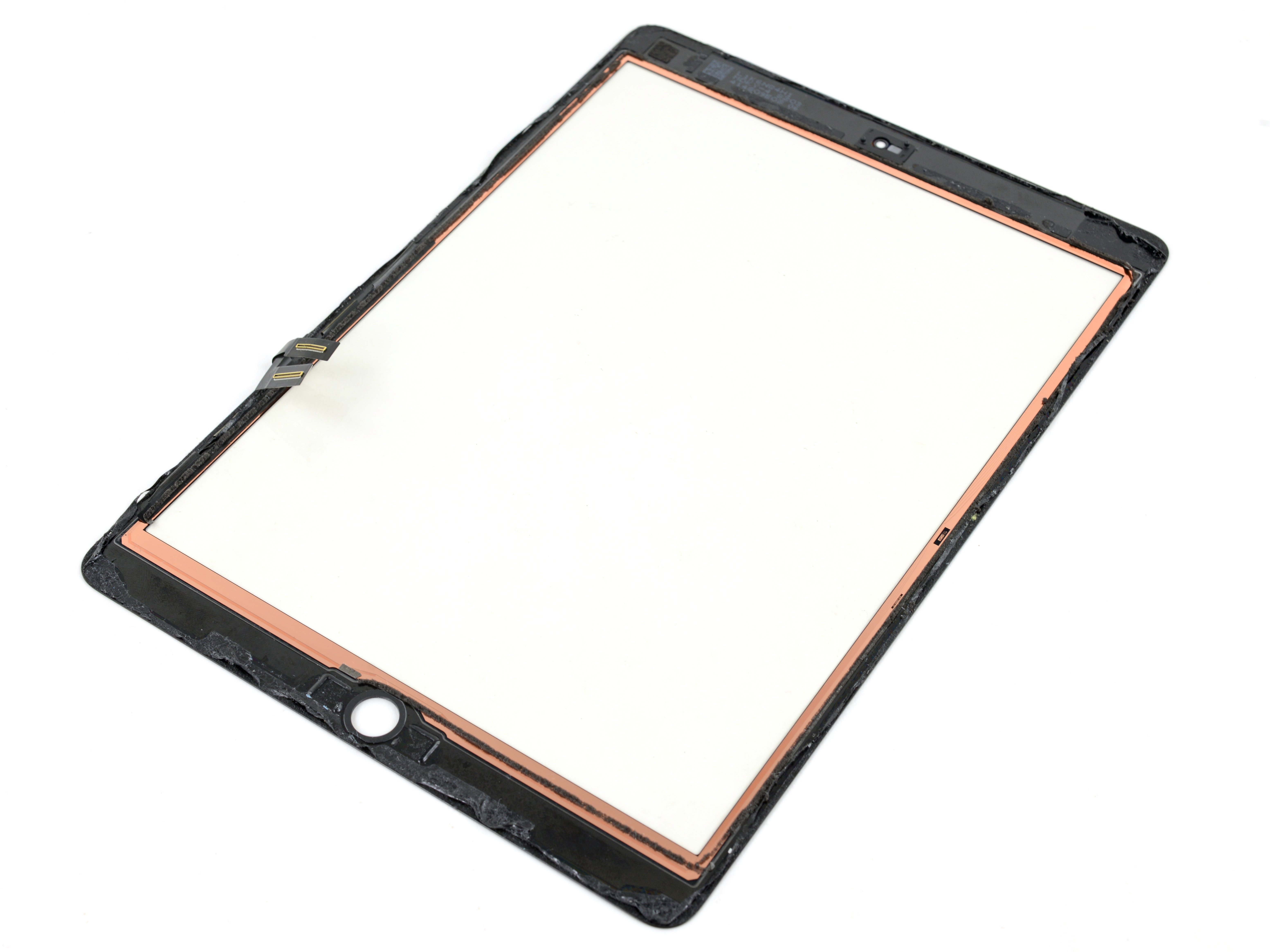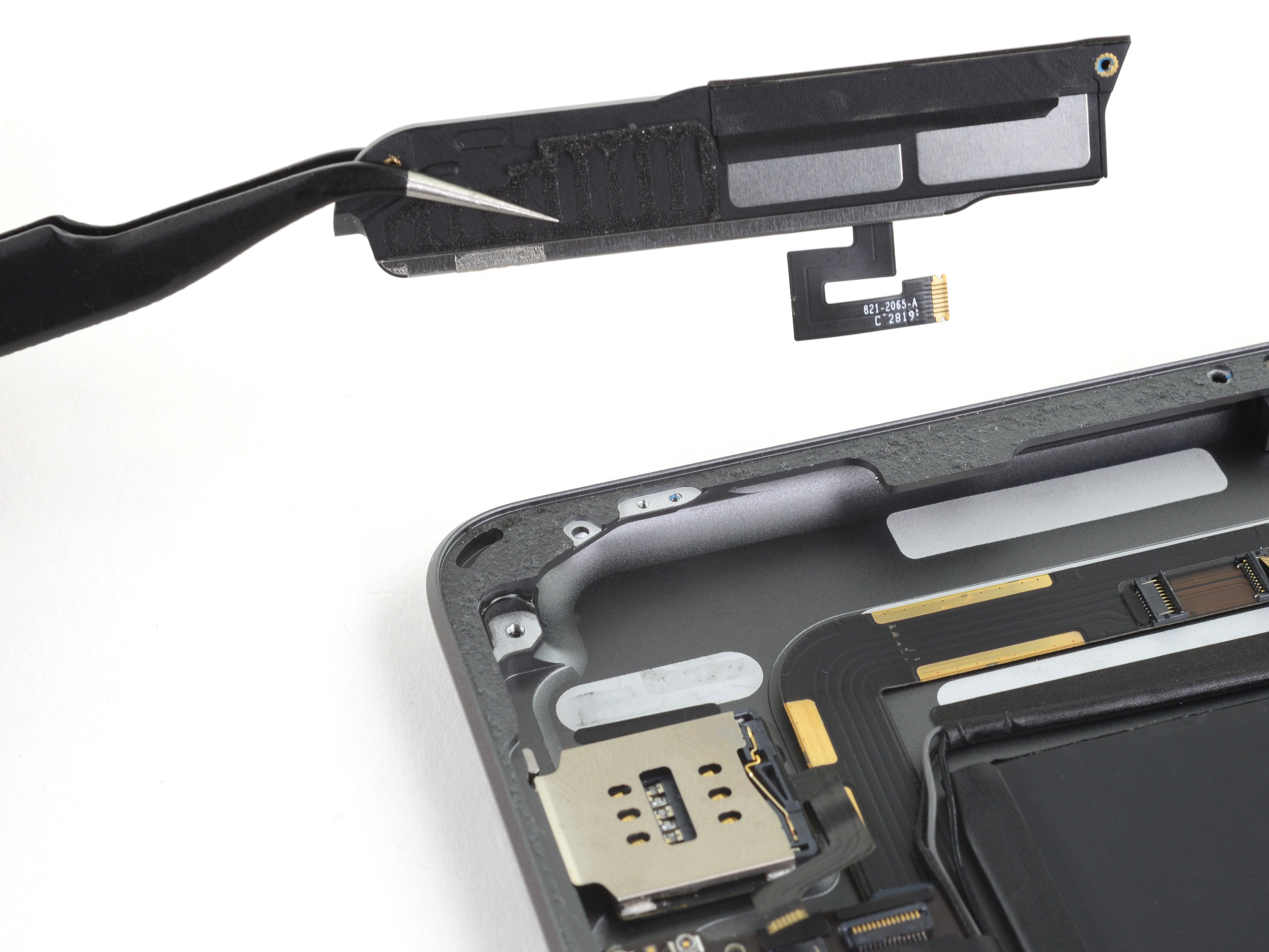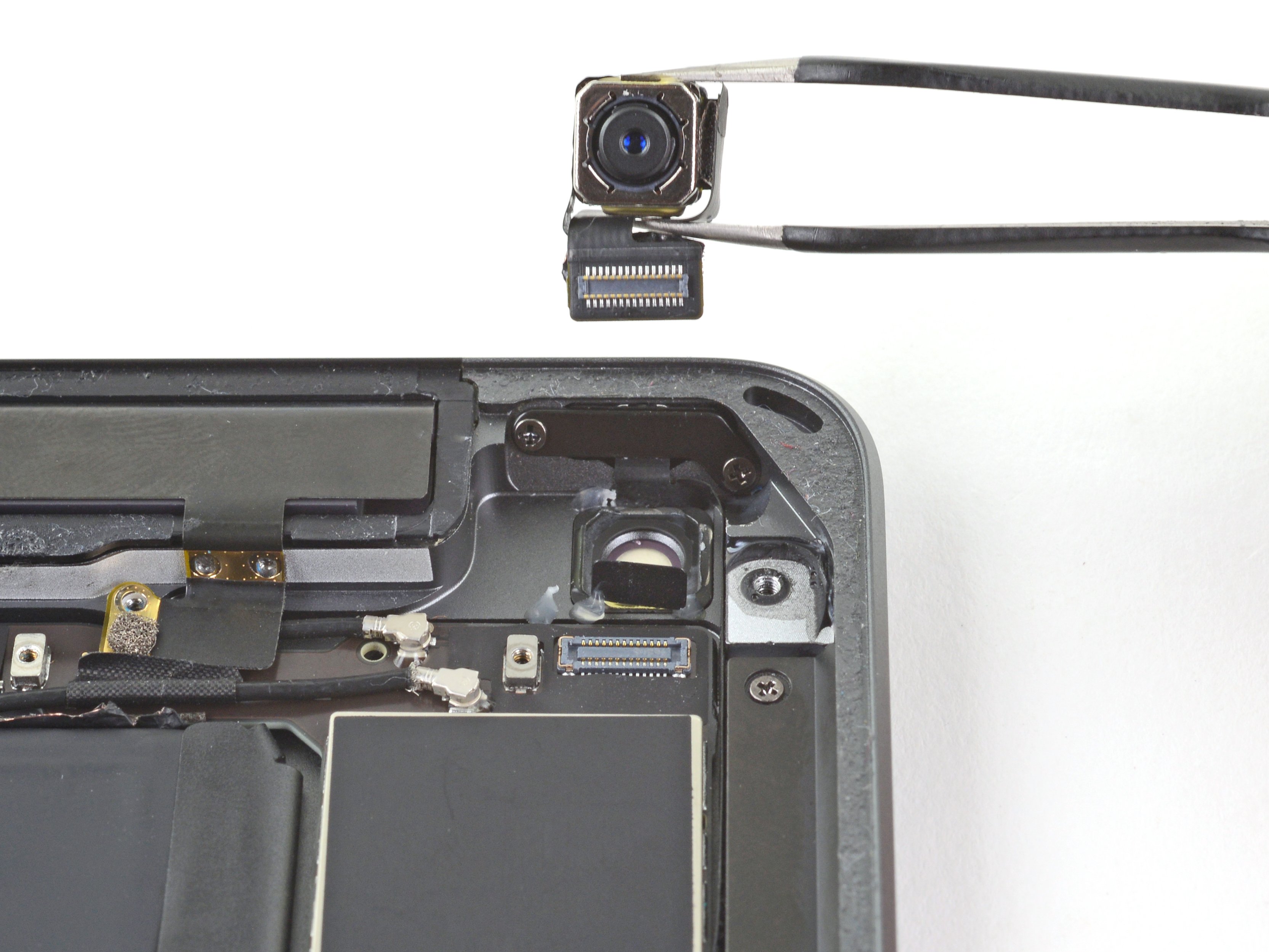iPad 8 LTE SIM Card Reader Replacement
Duration: 45 minutes
Steps: 53 Steps
Follow this guide to swap out the SIM card reader on your iPad 8 LTE. Heads up: this is just for the LTE model—if you have the Wi-Fi version, click here instead. When isolating the battery with a blocker, handle it gently; those battery contacts are fragile and can easily bend or break, causing permanent damage. If you decide to skip isolating the battery, steer clear of metal tools unless absolutely necessary (like for screws) to avoid short circuits and harm to delicate components. Some images might show a slightly different model, but don’t worry—they won’t mess with the steps.
Step 1
- Warm up an iOpener and stick it on the left edge of your device for a solid two minutes to loosen things up.
Tools Used
Step 2
- While you're letting the adhesive do its thing and loosen up, keep an eye on these delicate areas that need some extra care when prying:
- Front camera
- Antennas
- Display cables
Step 3
The next three steps introduce the Anti-Clamp, our nifty tool that makes opening things a breeze. If you're not using it, no worries—skip ahead three steps for a backup method.
Need a deeper dive into how the Anti-Clamp works? Check out this guide for all the deets.
If your iPad’s surface is a bit too slick for the Anti-Clamp to get a good grip, just stick some tape on it for a little extra traction.
- Slide the blue handle back to release the Anti-Clamp's arms. It's like unlocking a secret—kind of awesome!
- Place your iPad on something soft to keep it steady and level between the suction cups. A little cushion never hurt anyone.
- Now, grab your suction cups and place them on the left side—one on the top, one on the bottom. Aim for the middle, like you're setting up the perfect shot.
- Hold the bottom of the Anti-Clamp in place, and give the top cup a firm press to create some serious suction power. You've got this!
Step 4
- Gently pull the blue handle forward to lock those arms in place.
- Turn the handle clockwise a full 360 degrees, or until you feel the suction cups stretching into action.
- Keep an eye on the suction cups to make sure they stay in perfect alignment. If they start to drift, simply loosen them a bit and get them back in line.
Step 5
Take it easy—don’t twist more than half a turn at a time, and give it a minute to breathe between each turn. Let the Anti-Clamp and a little patience do their thing.
For a step-by-step guide on using a hair dryer like a pro, check out this handy resource.
If the Anti-Clamp isn't giving you the gap you need, don't fret! Just apply a little more heat to the spot and give that handle a gentle clockwise twist for half a turn.
- Give it a minute to let the adhesive loosen up and create a little gap to work with.
- If the screen isn’t warming up enough, try gently heating the left edge of the iPad with a hair dryer.
- Once the Anti-Clamp opens a decent gap, slide an opening pick under the digitizer to start the separation.
- Skip the next step.
Step 6
- When the screen feels warm to the touch, grab your suction handle and stick it right on the left edge of the screen, as close to the edge as you can get.
- Gently lift the screen using the suction handle to create a tiny gap between the digitizer and the frame.
- Slide an opening pick into the gap between the digitizer and the frame to start the separation.
If your screen's totally shattered, no worries! A bit of clear packing tape can help your suction cup stick better. Or, if you’re feeling adventurous, grab some strong tape as a replacement for the suction cup. Worst-case scenario? Superglue the suction cup straight to the screen—just make sure you’ve got a steady hand! If this sounds like a bit much, don't hesitate to schedule a repair.
Tools Used
Step 7
No need to panic if you spot the opening pick peeking through the digitizer — just gently pull it out. Your LCD screen should remain unscathed, but keep in mind you might leave behind some pesky adhesive that’s a bit of a hassle to clean up.
- Pop in a second opening pick into that lovely little gap you just made.
- Gently slide the pick over to the bottom-left corner of your device to break free from the adhesive's grip.
- Keep the pick snug in the bottom-left corner to stop the adhesive from getting too cozy again.
Step 8
- If the opening pick sticks to the adhesive, try gently rolling it along the edge of the iPad to keep the adhesive separating. Take it slow and steady – you've got this!
Step 9
- Gently slide the first opening pick towards the top-left corner of the device to loosen up that sticky adhesive.
- Keep the pick wedged in the top-left corner to stop the adhesive from snapping back together.
Step 10
- Warm up an iOpener and stick it onto the top edge of your device for a solid two minutes to get things nice and toasty.
Tools Used
Step 11
- Twist that trusty pick around the top-left corner of your device to break free from the adhesive's grip!
Step 12
Keep that pick away from the front camera—no one wants a scratched lens! Follow these steps to keep your device safe and sound.
- Gently glide the opening pick along the top edge of the device, stopping right before you hit the front camera.
Step 13
- Gently pull the pick out so only its tip stays tucked between the digitizer and the frame.
- Carefully slide the pick just above the front camera to loosen the adhesive.
- Keep the pick resting near the right side of the front camera before moving on.
Step 14
- Slide the pick back in and gently glide it to the top-right corner to fully cut through the top adhesive.
- Keep the pick lodged in that corner to stop the adhesive from snapping back together.
Step 15
- Warm up an iOpener and stick it on the right edge of your device for a couple of minutes to get things nice and toasty.
Tools Used
Step 16
- Gently twist the pick around the top-right corner of the device to loosen the adhesive and get things moving.
Step 17
The display cables hang out about halfway up from the bottom of your iPad. Stop sliding once you get to roughly three inches from the bottom to avoid any surprises.
- Grab a new opening pick and gently slide it right into the center of the iPad's right edge. You've got this!
Step 18
- Warm up that iOpener and give it a cozy spot on the bottom edge of your device for a full two minutes.
Tools Used
Step 19
Avoid spinning the pick all the way around the corner to keep the antenna safe and sound.
- Gently slide the pick into the bottom-left corner to break the adhesive's grip.
- Leave the pick in place as you prep for the next step—it's your trusty sidekick now!
Step 20
Slide the pick gently toward the home button—steering clear the other way might mess with the antenna, and we don't want that!
If you need to glide the pick over this part again, just pull it out and pop it back in at the bottom-left corner. Easy peasy!
- Slide a fresh opening pick into the gap you just created along the iPad's bottom edge.
- Gently glide the pick over the antenna, but stop just shy of the home button.
- Keep the pick to the left of the home button and carry on from there.
Step 21
Be sure to gently insert the pick no more than 1 mm to keep the right antenna safe and sound!
- Slip an opening pick into the little gap you've made. You're doing great!
- Gently glide the pick under the home button, heading toward the bottom-right corner. Just the tip should be wedged between the digitizer and the frame—nice and easy!
Step 22
Slide the pick gently towards the home button – don't push it the other way, or you might mess with the antenna. Stay cool and keep it smooth!
If you find yourself needing to slide the pick over this area again, just pull it out and re-insert it from the bottom-right corner.
- Grab the pick again and gently slide it towards the home button to fully separate that stubborn bottom adhesive. It’s almost free!
- Leave the pick snugly to the right of the home button before moving on. Keep it in place as you go.
Step 23
- Warm up your iOpener and gently press it to the right edge of your device for about two minutes. Give it some time to work its magic!
Tools Used
Step 24
Take your time with this step, it's important! Make sure the adhesive is nice and toasty, and gently work your pick to separate all the sticky bits. If you need to pause and reheat, that's totally okay—better safe than sorry!
If you’re feeling some serious resistance, give the edges a little heat and gently work your way around with the opening pick. Take it slow and steady, and the parts should start to loosen up!
- Gently twist the two opening picks placed on the left corners of the iPad to nudge the digitizer up a bit, helping to break the last bits of adhesive holding it down.
Step 25
- Gently lift the left edge of the digitizer upward to loosen the adhesive along the right side of your iPad a bit more.
Step 26
- Keep a steady hand on the digitizer while gently sliding an opening pick between the two display cables to carefully loosen the last bit of adhesive.
Step 27
- After you've carefully loosened all the adhesive, gently open the digitizer like a book and lay it flat next to the iPad.
- When putting things back together, give the frame and the digitizer (if you’re reusing it) a good clean with some isopropyl alcohol to remove leftover adhesive. Then, swap in fresh adhesive strips or pre-cut adhesive cards to keep everything secure.
- Keep an eye on those display cables while reassembling! Fold them neatly under the LCD screen to avoid any damage and keep your device happy.
Step 28
- Grab your trusty tweezers or just your fingers and gently peel away any tape that’s hiding those sneaky LCD screws.
Tools Used
Step 29
- Grab your trusty Phillips screwdriver and carefully take out the four 4.3 mm screws holding the LCD screen in place.
Step 30
The LCD is gently sticking to the frame, but don’t worry—it’s not a permanent bond! A little nudge should do the trick.
- Slide a spudger into the gap between the frame and the top-right corner of the LCD. You're making progress!
- Gently pry with the spudger to peel away the adhesive. Take your time – you've got this!
Tools Used
Step 31
- Now, let's tackle the top-left corner of the LCD just like we did before. You've got this!
Step 32
Hold on there! Don't go trying to yank the LCD off just yet—it's still hanging out with a flex cable.
- Grab your trusty spudger and gently pry the LCD from its snug little home just enough so you can get a good grip with your fingers.
- Now, give that LCD a little flip like you’re turning a page in a book, lifting it near the camera and gracefully flipping it over the home button end of the frame.
- Carefully place the LCD on a clean, soft, lint-free surface so you have easy access to those display cables. You've got this!
Tools Used
Step 33
- Grab your Phillips screwdriver and carefully remove the 2.3 mm-long screw holding the battery connector down to the logic board. Keep it safe!
Step 34
Check out these snapshots that give you a peek at the battery connector hiding beneath the logic board. Use them as your trusty guide while you carefully disconnect the battery.
You'll notice that the battery connector is equipped with cantilever springs on the logic board that snugly press against the battery contact pads. Since both the logic board and battery are glued down, it's time to get creative! Gently slide something thin and flexible between the contact points to make that battery disconnect.
Step 35
Handle the battery blocker with care! Those battery contacts are delicate little things that can bend or snap easily, causing damage you can’t undo.
Make sure the iFixit logo on the battery blocker is facing upwards, like a proud flag! Remember, don't shove that battery blocker under the connector like you're trying to win a game of tug-of-war. If it’s being stubborn, grab a playing card to help disconnect the battery instead; it’s a smoother move! The battery blocker or playing card should slide in easily below the logic board, with no obstacles in the way. Once it's in, it should sit at a chill 15-degree angle.
- Gently slide that battery blocker right under the logic board's battery connector at a cool 35-degree angle. You got this!
- Keep that battery blocker snug in place while you tackle the rest of the repair.
Tools Used
Step 36
- Grab your trusty Phillips screwdriver and unscrew the three 1.4 mm screws that are holding down the display cable bracket. Easy peasy!
Step 37
- Gently use tweezers or your fingers to lift off the display cable bracket.
Tools Used
Step 38
- Grab your trusty spudger and gently pry up to disconnect the LCD cable press connector. Easy peasy!
- When it's time to reattach those press connectors, just take your time! Align one side carefully and press it down until you hear that satisfying click. Then, do the same for the other side. You're doing great!
- Remember, skip the middle when pressing down. Misalignment can bend those delicate pins, and we definitely don’t want that! Keep it cool and take it slow.
Tools Used
Step 39
- Carefully lift the LCD off and gently place it face down on a soft, clean surface free of lint. This gives it a nice, comfy spot while you work on the rest!
Step 40
- Grab some tweezers and gently lift the tape hiding the home button cable’s ZIF connector like a pro.
Tools Used
Step 41
- Grab your trusty spudger, an opening tool, or even your fingernail and gently lift the tiny, hinged locking flap on the home button cable ZIF connector. You've got this!
Tools Used
Step 42
- Grab a pair of tweezers and gently pull the home button ribbon cable straight out of the ZIF connector. No rush—take your time, and be gentle with that delicate ribbon!
Tools Used
Step 43
Be gentle and only pry on the connectors themselves—trying to nudge the socket on the logic board is a quick way to cause trouble for your iPad.
- Grab your trusty spudger and gently lift up to disconnect those two digitizer cable press connectors. You've got this!
Tools Used
Step 44
Be super careful not to poke or rip that home button ribbon cable!
- Gently slide the flat end of your trusty spudger underneath the vibration isolator just below the SIM card reader to lift it up.
- Carefully take out the vibration isolator and set it aside.
Tools Used
Step 45
The cable's got a little sticky friend holding it in place, nothing too serious!
- Grab a trusty pair of tweezers and carefully peel the home button cable away from the rear case. You've got this!
Tools Used
Step 46
Grab your trusty opening pick and gently slice through any leftover adhesive that’s still holding the front panel assembly to the frame—let's liberate that screen!
Watch out! If these areas of the digitizer aren’t insulated, they might accidentally ground out against other components, leading to some touch input hiccups. Yikes!
This insulation is a sneaky little thing—not visible to the naked eye and quite different from the foam dust barrier strips you might find on many iPads.
- Take off the front panel assembly with care.
- If your new display starts acting up with those sneaky "ghost" or "phantom" touches, a little trick is to stick a super thin insulating tape like Kapton (polyimide) tape on the highlighted spots on the back of the panel. Replacement digitizers already come with the right insulation, so you probably won't need to add tape.
- When putting everything back together, make sure to scrape off any leftover adhesive from the iPad, then clean the sticky areas using high concentration isopropyl alcohol (90% or above) and a lint-free cloth. This step gets the iPad ready for fresh adhesive so it sticks like a charm.
- Give your iPad a test run to check all functions, then apply pre-cut adhesive strips to the back of the display following the display adhesive application guide before sealing it up tight.
Step 47
- Grab your trusty SIM eject tool, a bit, or even a straightened paper clip. Now, let's get this party started by inserting it into the SIM card tray hole.
- Give it a good press to pop that SIM card tray out like a pro!
Step 48
- Pop out the SIM card tray from your iPad to get started.
Step 49
- Gently use the tip of a spudger, an opening tool, or even your fingernail to lift up the tiny, hinged locking flap on the SIM card reader cable’s ZIF connector.
Tools Used
Step 50
- Grab your trusty tweezers and gently wiggle the SIM card reader cable straight out of the ZIF connector—steady hands win the race!
Tools Used
Step 51
- Warm up an iOpener and place it on the bottom left corner of the rear case to gently loosen the SIM card tray's adhesive—give it about thirty seconds to work its magic.
Tools Used
Step 52
If the SIM card reader is giving you a bit of a workout, don’t sweat it! Just add a little more heat and give it another go.
- Gently wedge an opening tool under the bottom edge of the SIM card reader and lift it up with a slow, steady motion.
Step 53
- Now, just put everything back together in the reverse order, and you'll be good to go!
- Got some old e-waste lying around? Make sure to drop it off at an R2 or e-Stewards certified recycler.
- Things not going quite as planned? No worries! Try some basic troubleshooting, or if you're stuck, our community is here to help.
-










































































































































